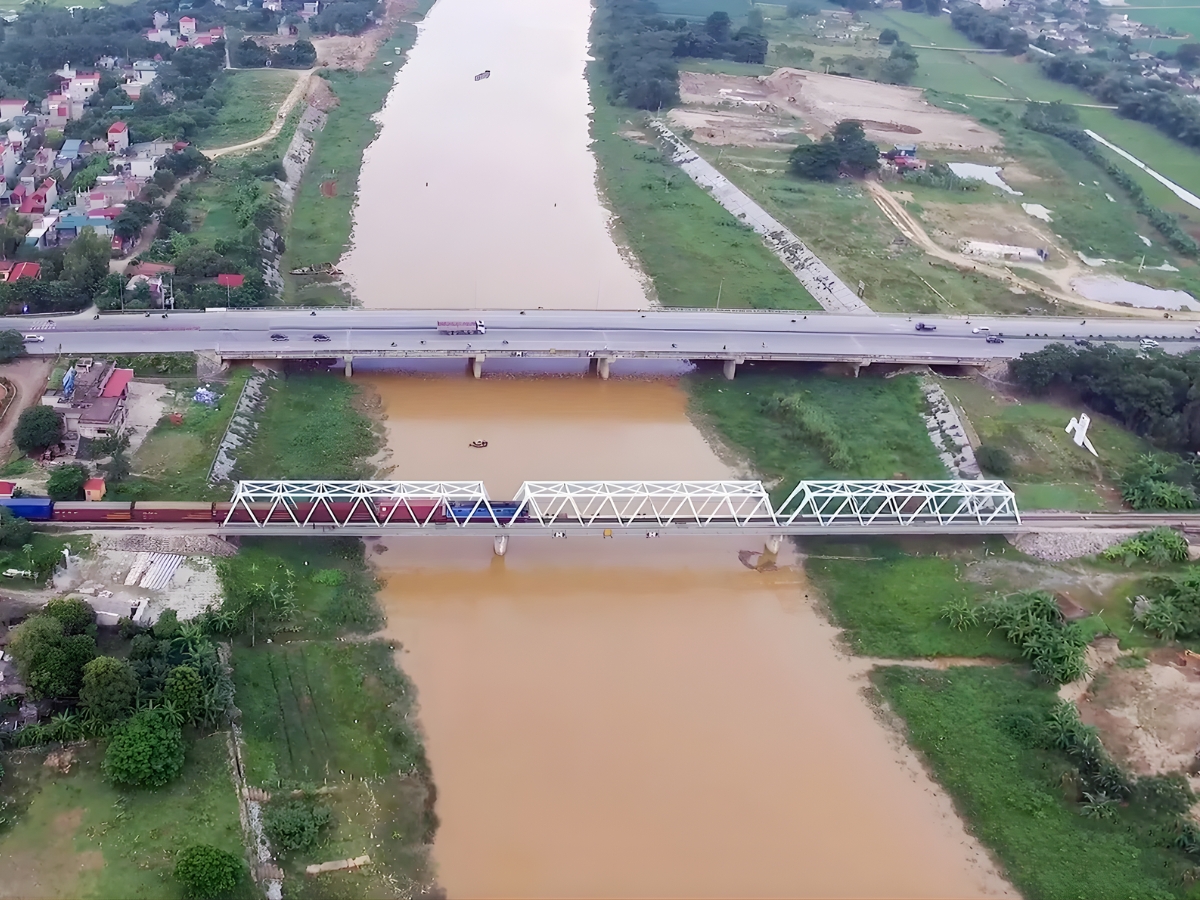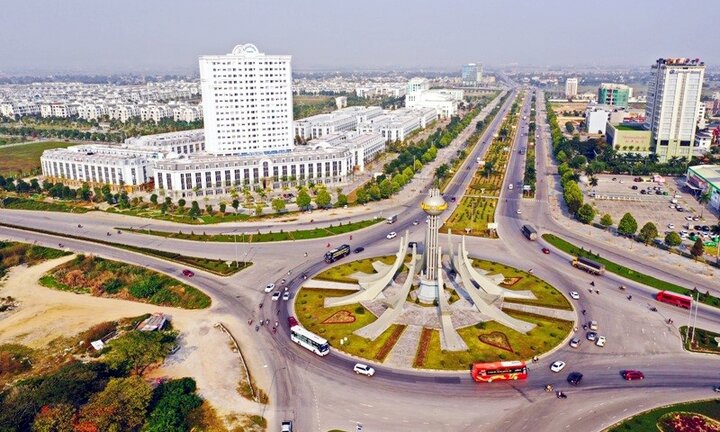1. Location, history, and importance of Do Len Bridge
1.1. Location of Do Len Bridge and its role in North-South transportation
Located on National Highway 1A, Do Len Bridge is in Ha Trung commune, Thanh Hoa province. The bridge spans the Len River, a branch of the Hoat River, serving as a crucial connection point between the North Central region and the northern provinces.
With this strategic location, Do Len Bridge is considered one of the vital transportation routes on the North-South axis, contributing to shortening travel time and reducing the load on the central region's bridge and road system. The project not only replaces dangerous intersections between road and rail that previously existed but also ensures safety and smooth operation for freight and passenger transport across Vietnam. As a result, Do Len Bridge has become an important link in the national transportation network, while also promoting the socio-economic development of Ha Trung area in particular and Thanh Hoa province in general.
1.2. Do Len Bridge: A Witness to History
Appearing in the early 20th century, Do Len Bridge was not only a key transportation project but also associated with the comprehensive transformation of the Len land area. With the construction of the bridge, the social landscape of this region gradually flourished. On National Highway 1A, a train station, Len street, and a French-Vietnamese primary school emerged, creating a bustling commercial center.
Entering the resistance period against the French, Do Len Bridge became a vital military target. In late 1946 and early 1947, in response to the "scorched earth resistance" policy, the bridge was destroyed to halt the enemy's advance. After peace was restored, with the support of experts from fraternal socialist countries, the bridge was rebuilt more spacious and sturdy, becoming one of the crucial transportation hubs on National Highway 1A connecting the North and South.
Notably, on April 3-4, 1965, Do Len Bridge, along with Ham Rong Bridge, became a "hotspot" when targeted by intense bombing from the US Air Force. However, the army and people of Ha Trung bravely fought, shooting down 12 US aircraft and safely protecting the vital transportation route. This resounding victory not only demonstrated the courageous spirit and resilient will of the people of Thanh Hoa but also cemented the name of Do Len Bridge as a symbol of patriotism and national unity.

Do Len Bridge is a historical witness to the two resistance wars against France and America. (Source: Collected)
Today, when stopping by the bridge that has gone through many temporal changes, visitors can still feel the intact breath of history. This place was once a witness to glorious years, contributing to the golden pages of the nation's history.
2. Cultural significance and traditional value of Do Len Bridge
Spanning over a century, Do Len Bridge is not only a vital transportation route but also a cultural symbol and the pride of the people of Thanh land. The image of the bridge spanning the Len River has entered the memories of many generations, becoming a vivid testament to the resilient will and spirit of solidarity during the war years as well as in the cause of building the homeland today.

Do Len Bridge is a cultural symbol, the pride of the people of Thanh Hoa. (Source: Collected)
Nowadays, Do Len Bridge carries profound educational value, contributing to fostering patriotism and inspiring the younger generation about the heroic tradition of the land of Ha Trung – Thanh Hoa. In recent years, the locality has been striving to preserve and promote the historical value of the bridge through relic restoration projects, developing the Do Len – Ham Rong historical and cultural tourism route, combining communication and promotion of the relic's image on digital platforms. These steps not only help spread the value of Do Len Bridge but also affirm the importance of heritage in the journey of preserving memory and developing sustainable tourism for Thanh Hoa.
3. The most detailed journey to discover Do Len Bridge
3.1. Suggested means of transport and directions to Do Len Bridge
With its convenient location on National Highway 1A, getting to Do Len Bridge is quite easy, whether you are starting from Hanoi, Thanh Hoa, or Ho Chi Minh City.
Starting from Hanoi:
From Hanoi, visitors can travel by car or motorbike along the Hanoi – Ninh Binh expressway, then turn onto National Highway 1A and drive straight south. Upon reaching Ha Trung commune, the majestic iron bridge spanning the Len River will appear before your eyes, taking only about 2.5 – 3 hours of travel. Alternatively, you can also choose bus trips from Giap Bat or Nuoc Ngam bus stations to Thanh Hoa, then get off in the Ha Trung area and take a short motorbike taxi or taxi ride to reach the destination.
Starting from Ho Chi Minh City:
Visitors can fly to Tho Xuan Airport (Thanh Hoa), then travel by car or taxi to reach Hac Thanh ward, then continue along National Highway 1A north to Do Len Bridge. This is the quickest and most convenient option for those coming from the South who want to explore the historical beauty of this legendary bridge.
Starting from Thanh Hoa:
Visitors travel along National Highway 1A north, passing over Tao Xuyen Bridge for about 40 – 45 minutes to reach Do Len Bridge. The road is flat and easy to travel, suitable for cars, motorbikes, or small tourist vehicles.
3.2. Check-in at Do Len Bridge and unmissable experiences
Coming to Do Len Bridge, visitors can not only admire a structure of historical value but also have the opportunity to experience many memorable moments. One of the most wonderful experiences is watching the sunset over the Len River. In the late afternoon, as the sun gradually sets behind the bamboo groves, the orange-red sunset reflects on the water surface, weaving through each iron span of the bridge, creating a space that is both majestic and poetic. Standing on the bridge at that moment, all worries seem to disappear, leaving only a sense of peace amidst the sound of the wind and the slow pace of rural life.
With the scenery of the ancient iron bridge, the gentle Len River, and the late-day sunlight, this place is also a very "poetic" check-in spot for photography lovers. Visitors can choose to stand on the new bridge to capture the entire view of the old bridge, or find a safe spot on the walkway to take photos with nostalgic and classic colors. Every angle, every frame tells a story of memory, of time, and the enduring beauty of a century-old historical relic. Don't forget to participate in commemorative activities and listen to stories from local people to understand more about the "hotspot" that once marked the heroic achievements of the army and people of Ha Trung during the war years.
Besides that, observing the simple life of the riverside people is also an experience that makes many visitors linger. Amidst the peaceful scenery, visitors will encounter fishermen diligently casting their nets, innocent children playing, or quiet ferry boats taking passengers across the river. All create a simple yet vibrant picture of everyday life at Do Len Bridge.
3.3. Visiting Tran Pagoda (Phuc Linh Tu) and exploring nearby tourist attractions
After visiting Do Len Bridge, visitors can continue their journey to Tran Pagoda (Phuc Linh Tu). From Do Len Bridge, visitors only need to travel a few kilometers south to reach the place. The pagoda is located in a serene space, surrounded by greenery and a lake, creating a sense of peace for those seeking tranquility. Upon arrival, visitors can worship Buddha, offer incense for peace, and admire the ancient architecture bearing the strong imprint of the Le – Nguyen dynasties. Every early spring occasion, the Tran Pagoda festival attracts a large number of Buddhists and visitors from all directions to pilgrimage and participate in traditional spiritual and cultural activities of the people of Thanh Hoa.
From the pagoda area, visitors can combine exploring many other historical relics and interesting destinations in Ha Trung such as Nguyen dynasty tombs, ancient schools, or old workshops,... Furthermore, the travel itinerary can also be extended with nearby notable destinations such as the sacred Song Son Temple, the famous Nga Son rush mat village, the vibrant Sam Son beach square, and the Am Tien legend area under construction, promising to become a new spiritual tourism center of Thanh Hoa.

Huyen Tich Am Tien promises to become a new spiritual tourism center of Thanh Hoa. (Source: Bao Thanh Nien)
The connection between Do Len bridge, Chua Tran, and other destinations in the area creates a complete tourist route. Visitors can worship, learn about culture, and experience the natural scenery and history deeply imprinted on the Thanh Hoa region.
The Do Len bridge is not only a vital transportation work but also a vivid historical witness, marking many glorious victories of the army and people of the Thanh Hoa region. Once a “hot coordinate” during the years of the war against America, the bridge still stood proudly amidst bombs and bullets, becoming a symbol of the indomitable will and unyielding spirit of the Vietnamese people. Today, amidst peaceful life, the Do Len bridge still stands majestically across the Len river, silently recounting the heroic stories of the past, reminding each generation of the value of peace, patriotism, and pride in an eternal historical heritage of the Thanh Hoa region.







